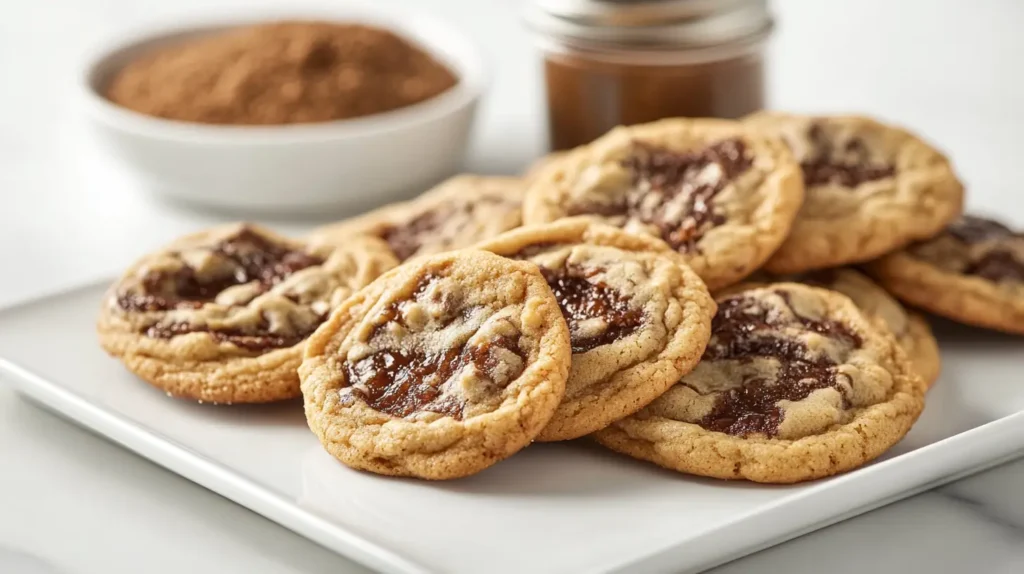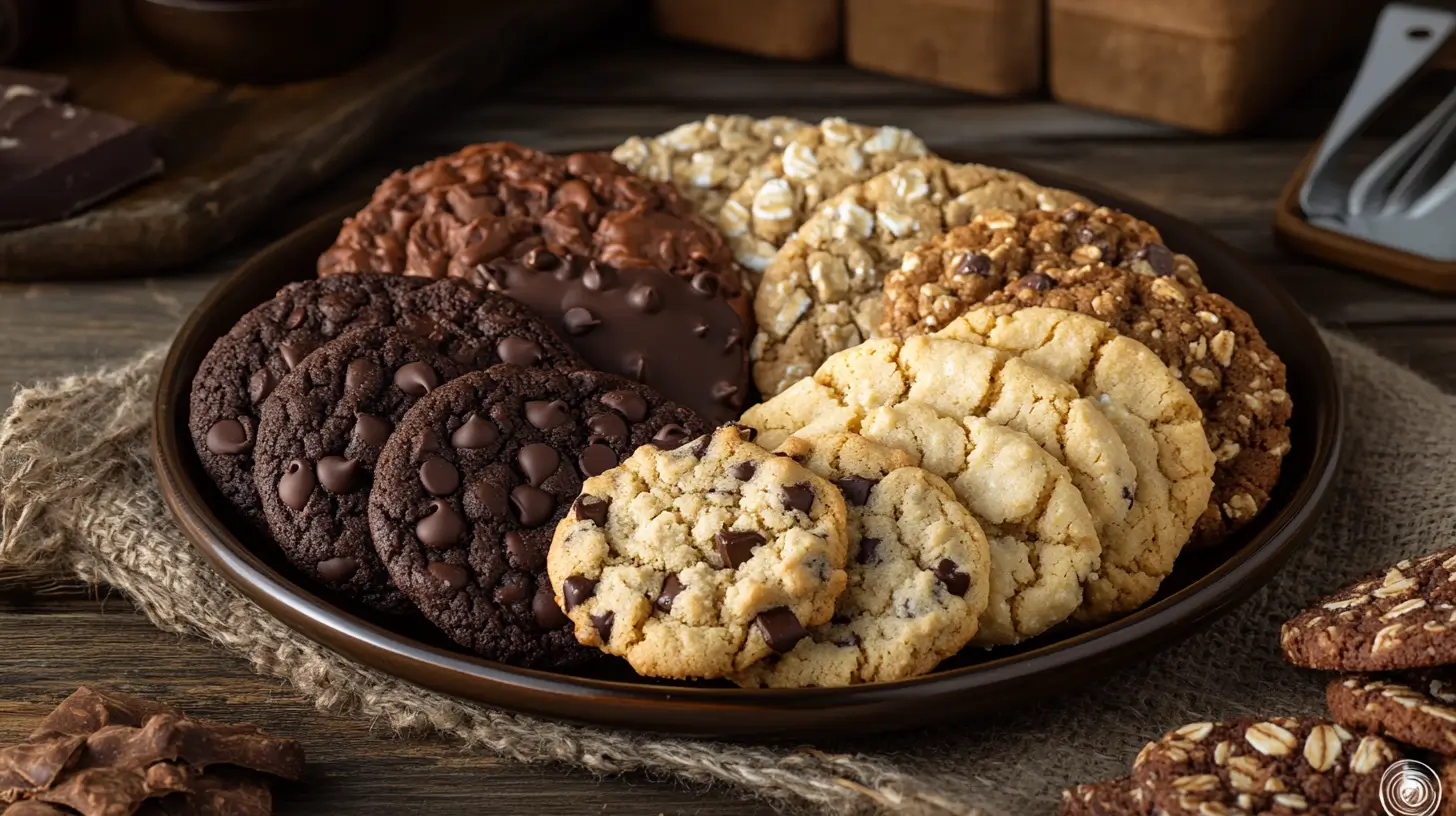Introduction
What This Article Cover
Cookies are a beloved treat, and the ingredients that go into them each play a unique role in shaping their taste, texture, and appearance. In this article, we’ll uncover what brown sugar does in cookies, exploring its chemistry, flavor impact, and contributions to texture and structure. Whether you’re an experienced baker or just starting out, understanding how brown sugar influences your cookies will improve your baking results.
Importance of Understanding Brown Sugar’s Role in Baking
Brown sugar is more than just a sweetener. Its unique properties make it indispensable in creating the perfect cookie. From its moisture-retaining qualities to its contribution to caramelization, knowing what brown sugar does in cookies equips you with the tools to customize recipes to your liking.
Composition of Brown Sugar
What Is Brown Sugar?
Brown sugar is a form of sucrose with molasses added back in, which gives it a distinct color, flavor, and texture. Unlike white sugar, it contains both sugar crystals and molasses, providing a slightly acidic nature. This acidity contributes to its unique interactions in baked goods.
Brown sugar comes in two primary varieties: light and dark. Each type contains different levels of molasses, which affect both flavor and moisture content. What does brown sugar do in cookies is deeply tied to these differences.
Differences Between Light and Dark Brown Sugar
- Light Brown Sugar: Contains approximately 3.5% molasses. It lends a mild caramel flavor to cookies and keeps them tender.
- Dark Brown Sugar: Contains about 6.5% molasses, resulting in a more robust flavor and added moisture.
When deciding what brown sugar does in cookies, consider that light brown sugar creates milder flavors, while dark brown sugar intensifies richness.
Chemistry of Brown Sugar
Molecular Structure
Brown sugar’s composition is a mix of sucrose and molasses, giving it hygroscopic (moisture-attracting) properties. This hygroscopic nature is crucial in determining what brown sugar does in cookies, as it impacts both moisture retention and texture.
The molasses component also introduces trace minerals and acids, which react with leavening agents to produce carbon dioxide. This reaction helps cookies achieve their characteristic rise.
Interaction With Other Cookie Ingredients
Brown sugar interacts with flour, butter, and eggs in unique ways. Its moisture content binds with proteins in flour, resulting in a softer dough. Additionally, its acidity works with baking soda to create tiny air pockets, contributing to a light yet chewy texture.
By understanding these interactions, you can better grasp what brown sugar does in cookies and why it is integral to achieving a perfect batch.
Sweetness and Flavor Impact
How Brown Sugar Affects Sweetness
Compared to white sugar, brown sugar provides a deeper, more complex sweetness due to the presence of molasses. This added depth enhances the overall flavor of cookies, making them richer and more satisfying.
Unique Flavor Profiles
The molasses in brown sugar contributes notes of caramel, toffee, and even a hint of smokiness. These flavors are amplified during baking as the sugar undergoes caramelization. To appreciate what brown sugar does in cookies, consider the unique character it imparts compared to white sugar’s neutral sweetness.
Texture Transformatio
Role of Moisture Content
Brown sugar’s moisture-retaining qualities help create a softer cookie texture. Its hygroscopic nature allows it to attract and retain water molecules, ensuring cookies remain tender and moist even after baking.
Impact on Chewiness and Crispness
What does brown sugar do in cookies in terms of texture? It primarily influences chewiness. The moisture from molasses keeps cookies soft, while its interaction with other ingredients balances spread and structure. For a crispier cookie, using a mix of brown and white sugar can achieve the desired effect.
Browning and Caramelization
Maillard Reaction
The Maillard reaction is a chemical process that occurs when amino acids and reducing sugars are exposed to heat. Brown sugar’s molasses content enhances this reaction, leading to a richer, darker color and complex flavors. This is one of the key elements of what brown sugar does in cookies.
Caramelization Process
When brown sugar is heated, its sucrose content breaks down into simpler sugars, which then caramelize. This process adds depth to both flavor and appearance, resulting in cookies with a golden-brown hue and a slightly crisp exterior.

Leavening Dynamics
Interaction With Baking Soda
The acidity in molasses reacts with baking soda to produce carbon dioxide, which helps cookies rise. This reaction is essential for achieving the characteristic spread and lift associated with many cookie recipes.
Contribution to Rise and Spread
Brown sugar’s impact on leavening goes beyond chemical reactions. Its moisture content softens the dough, allowing it to spread more evenly during baking. This combination of rise and spread is a hallmark of what brown sugar does in cookies.
Moisture Retention
Hygroscopic Nature of Brown Sugar
Brown sugar’s hygroscopic properties mean it attracts and holds onto moisture. This ability plays a key role in what brown sugar does in cookies, as it ensures the dough retains water during baking. This moisture retention creates cookies that are soft and tender, with a chewy interior.
The molasses content in brown sugar further amplifies this effect by binding water molecules. This unique characteristic makes brown sugar indispensable in recipes that require a moist texture.
Effect on Cookie Shelf Life
Brown sugar not only impacts the initial texture of cookies but also extends their freshness. By retaining moisture, it delays staleness, making cookies soft and enjoyable for longer. This is especially helpful when baking in large batches or for events. Understanding what brown sugar does in cookies helps bakers preserve the quality of their baked goods.
Substituting Brown Sugar
Alternatives to Brown Sugar
If you run out of brown sugar, there are several substitutes you can use:
- White Sugar + Molasses: Combine one cup of white sugar with one tablespoon of molasses for light brown sugar or two tablespoons for dark brown sugar.
- Coconut Sugar: Offers a similar texture but a more subtle flavor profile.
- Maple Syrup: Provides moisture and a caramel-like flavor but may alter the dough’s consistency.
These substitutes mimic what brown sugar does in cookies, but slight adjustments may be needed.
Adjustments for Flavor and Texture
When substituting, consider the molasses content in brown sugar. Using alternatives may affect moisture levels, sweetness, and texture. To maintain what brown sugar does in cookies, you might need to tweak liquid ratios or adjust baking times for optimal results.
Light vs. Dark Brown Sugar
Which One to Use in Specific Recipes
Choosing between light and dark brown sugar depends on your recipe and flavor preferences:
- Light Brown Sugar: Ideal for recipes where a mild caramel flavor is desired, such as snickerdoodles or shortbread cookies.
- Dark Brown Sugar: Perfect for recipes requiring bold, molasses-forward flavors, like gingerbread cookies or molasses crinkle cookies.
By understanding what brown sugar does in cookies, you can select the right type to achieve the intended taste and texture.
Flavor and Color Considerations
Light brown sugar adds a subtle golden hue, while dark brown sugar imparts a deeper color and richer taste. For visual appeal and flavor depth, many recipes specify the type of brown sugar to use. Knowing what brown sugar does in cookies allows bakers to experiment with these variations for desired results.
Popular Cookie Recipes
Classic Chocolate Chip Cookies
Brown sugar is a staple in chocolate chip cookie recipes. Its moisture-retaining properties create a chewy texture, while its molasses content enhances the cookie’s caramelized flavor. For a soft, chewy classic, understanding what brown sugar does in cookies is essential.
Brown Sugar Cookies
These cookies showcase brown sugar as the star ingredient. The result is a rich, tender cookie with notes of caramel and toffee. They highlight the sweetness and moisture retention properties that define what brown sugar does in cookies.
Specialty Cookie Varieties
From oatmeal raisin to spiced holiday cookies, brown sugar is a versatile ingredient. Its unique attributes adapt to various flavors and textures, ensuring each cookie type benefits from its signature sweetness and moisture.

Troubleshooting Tips
Common Problems When Using Brown Sugar
Sometimes, using brown sugar can lead to issues such as:
- Overly Flat Cookies: This may occur if the dough lacks structure. Balancing brown sugar with white sugar or increasing flour can help.
- Dry Cookies: This might happen if the brown sugar is not packed correctly or if it’s too old and dry.
Understanding what brown sugar does in cookies equips bakers to prevent or fix these problems.
How to Fix Overly Flat or Dry Cookies
- For flat cookies: Chill the dough before baking to reduce spread.
- For dry cookies: Add a tablespoon of milk or increase butter slightly to restore moisture.
Being aware of what brown sugar does in cookies ensures consistently perfect results.
Health Considerations
Nutritional Differences Between Brown and White Sugar
While brown sugar contains small amounts of minerals like calcium and potassium due to its molasses content, the differences are minimal. Both brown and white sugar are high in calories and should be used in moderation. Understanding what brown sugar does in cookies includes recognizing its contribution to overall dietary intake.
How Brown Sugar Fits Dietary Preferences in Cookie Recipes
For individuals on low-sugar diets or seeking alternative sweeteners, brown sugar substitutes like coconut sugar or natural syrups may offer a solution. These alternatives mimic what brown sugar does in cookies while catering to specific nutritional needs.
FAQs About Cookie Baking
Do You Need Vanilla Extract for Cookies?
While vanilla extract isn’t essential for the structural integrity of cookies, it’s crucial for enhancing flavor. Vanilla acts as a natural flavor enhancer, balancing the sweetness of sugar and complementing other ingredients like butter and chocolate. Without vanilla extract, cookies might lack depth and taste one-dimensional. If you’re out of vanilla, alternatives like almond extract, maple syrup, or even vanilla-flavored milk can provide a similar flavor boost.
What Does Butter Do in Baking?
Butter serves multiple purposes in baking, especially in cookies:
- Flavor: Butter imparts a rich, creamy flavor that enhances the overall taste of cookies.
- Texture: Depending on how it’s used, butter can make cookies soft and chewy or crispy and crumbly.
- Creamed Butter: Incorporates air into the dough, resulting in lighter, softer cookies.
- Melted Butter: Produces denser, chewier cookies by binding ingredients more closely.
- Structure: The fat in butter coats flour particles, limiting gluten formation and contributing to a tender texture.
- Spread: The temperature of butter affects how much cookies spread. Room-temperature butter leads to moderate spread, while cold butter reduces spread.
What Does Cornstarch Do to Cookies?
Cornstarch is a secret weapon for creating cookies with a soft, delicate texture. Its effects include:
- Tenderness: Cornstarch inhibits gluten development, making cookies softer and more tender.
- Thickness: Adding cornstarch can prevent cookies from spreading too much, resulting in thicker, more substantial cookies.
- Crispness: It helps create cookies with crisp edges and soft centers, perfect for achieving a balance in texture.
Cornstarch is commonly used in shortbread cookies or as part of a flour blend in recipes that call for a light and crumbly texture.
What Does Baking Soda Do to Cookies?
Baking soda (sodium bicarbonate) is a leavening agent that contributes to cookies’ texture and structure. Here’s what it does:
- Leavening: Baking soda reacts with acidic ingredients like brown sugar, buttermilk, or yogurt, releasing carbon dioxide gas. This reaction helps cookies rise and creates a lighter texture.
- Spread: Baking soda affects how cookies spread during baking. Its leavening action creates a looser dough, leading to wider, flatter cookies.
- Browning: Baking soda promotes browning by raising the pH of the dough, which enhances the Maillard reaction. This results in cookies with a rich, golden-brown color.
Understanding how baking soda works allows bakers to control the rise, spread, and color of their cookies for perfect results.
Conclusion
Recap of Brown Sugar’s Importance
Brown sugar plays a vital role in creating cookies that are flavorful, chewy, and visually appealing. Its moisture-retaining properties, contribution to flavor depth, and role in browning and caramelization make it indispensable in baking.
Final Tips for Baking Cookies With Brown Sugar
- Pack brown sugar tightly to ensure accurate measurements.
- Experiment with light and dark varieties for different flavor profiles.
- Store brown sugar in an airtight container to prevent it from hardening.
By mastering what brown sugar does in cookies, bakers can elevate their craft and consistently produce delectable treats.





